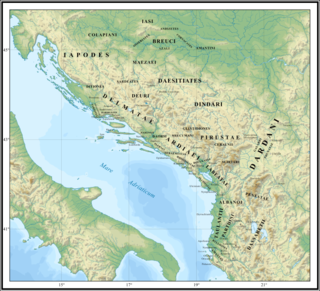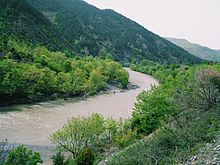
In classical and late antiquity, Illyria was a region in the western part of the Balkan Peninsula inhabited by numerous tribes of people collectively known as the Illyrians.
Taulantii or Taulantians were an Illyrian people that lived on the Adriatic coast of southern Illyria. They dominated at various times much of the plain between the rivers Drin (Drilon) and Vjosa (Aoös). Their central area was the hinterland of Epidamnos-Dyrrhachion, corresponding to present-day Tirana and the region between the valleys of Mat and Shkumbin (Genusus). The Taulantii are among the oldest attested Illyrian peoples, who established a powerful kingdom in southern Illyria. They are among the peoples who most marked Illyrian history, and thus found their place in the numerous works of historians in classical antiquity.

Apollonia was an Ancient Greek trade colony which developed into an independent polis, and later a Roman city, in southern Illyria. It was located on the right bank of the Aoös/Vjosë river, approximately 10 km from the eastern coast of the Adriatic Sea. Its ruins are situated in the county of Fier, close to the village of Pojan, in Albania.
The Ardiaei were an Illyrian people who resided in the territory of present-day Albania, Kosovo, Montenegro, Bosnia and Herzegovina, and Croatia between the Adriatic coast on the south, Konjic on the north, along the Neretva river and its right bank on the west, and extending to Lake Shkodra to the southeast. From the 3rd century BC to 168 BC the capital cities of the Ardiaean State were Rhizon and Scodra.
The Dexaroi were an ancient Chaonian tribe living under Mount Amyron. In ancient literature the Dexari are mentioned only by the ancient Greek writer Hecataeus of Miletus, cited by Stephanus of Byzantium. The Dexaroi were the northernmost tribe that belonged to the Chaonian group, one of the three major North-Western Greek-speaking tribes of Epirus.

Monounios or Monunius was an Illyrian king who reigned in southern Illyria, in the territory of the Taulantii, around the hinterland of Dyrrhachion and Apollonia. He is the first known Illyrian king to have struck his own silver coins, which were minted in Dyrrhachion. The fact that Monounios' coins were struck in the city mint of Dyrrhachion stresses that he exercised to some extent his authority over the city, as did his successor and probably son Mytilos later.
Mytilos or Mytilus was an Illyrian king who reigned in southern Illyria, around the hinterland of Dyrrhachion and Apollonia. He was the successor of Monunios, and probably his son. Mytilus is mentioned by Pompeius Trogus and Frontinus reporting the events of the military conflict between the Illyrians and the Epirotes under Alexander II, son of Pyrrhus. From around 270 BC Mytilus minted in Dyrrhachion his own bronze coins bearing the king's name and the symbol of the city.

The Bylliones were an Illyrian tribe that lived near the Adriatic coast of southern Illyria, on the lower valley of the Vjosa river, in the hinterland of Apollonia. The Bylliones were firstly attested in epigraphic material from the oracle of Dodona dating back to the 4th century BC, and their koinon was firstly attested in a 3rd-century BC inscription from the same oracle. Their territory was trapezoidal on the right side of the rivers Luftinje and Vjosa, extending in the west to the Mallakastra mountains. The chief city of their koinon was Byllis. Another important centre of their koinon was Klos, an earlier Illyrian settlement later called Nikaia, as an inscription attests. The Bylliones also inhabited in the area of an ancient sanctuary of the eternal fire called Nymphaion.

The Illyrian Kingdom was an Illyrian political entity that existed on the western part of the Balkan Peninsula in ancient times. Regardless of the number of the alternately ruling dynasties, of their tribal affiliation, and of the actual extension of their kingdom, it represented an alliance of Illyrian tribes that united under the rulership of a single leader, expressly referred to as "King of the Illyrians" in ancient historical records.
The Dassaretii were an Illyrian people that lived in the inlands of southern Illyria, between present-day south-eastern Albania and south-western North Macedonia. Their territory included the entire region between the rivers Asamus and Eordaicus, the plateau of Korça locked by the fortress of Pelion and, towards the north it extended to Lake Lychnidus up to the Black Drin. They were directly in contact with the regions of Orestis and Lynkestis of Upper Macedonia. Their chief city was Lychnidos, located on the edge of the lake of the same name. One of the most important settlements in their territory was established at Selcë e Poshtme near the western shore of Lake Lychnidus, where the Illyrian Royal Tombs were built.

The Labeatae, Labeatai or Labeates were an Illyrian people that lived on the Adriatic coast of southern Illyria, between modern Albania and Montenegro, around Lake Scodra.
Atintanes or Atintanians was an ancient tribe that dwelled in the borderlands between Epirus and Illyria, in an inland region which was called Atintania. They have been described as either an Epirote tribe that belonged to the northwestern Greek group, or as an Illyrian tribe. They were occasionally subordinate to the Molossians.
The Enchelei were an ancient people that lived around the River Drin and the region of Lake Shkodra and Lake Ohrid, in modern-day Albania, Montenegro, and North Macedonia. They are one of the oldest known peoples of the eastern shore of the Adriatic Sea. In ancient sources they sometimes appear as an ethnic group distinct from the Illyrians, but they are mostly mentioned as one of the Illyrian tribes. They held a central position in the earlier phase of Illyrian history. In ancient Greek literature they are linked with the end of the mythical narrative of Cadmus and Harmonia, a tradition deeply rooted among the Illyrian peoples.
Bardylis II was an Illyrian king, and presumably the son of Cleitus, and grandson of Bardylis. He was the father of Bircenna, wife of Pyrrhus of Epirus. Bardylis II is the only attested Illyrian king after Glaucias' death. He may have succeeded Glaucias on the throne as the grandson of Bardylis I, or alternatively he may have reigned independently after his father Cleitus somewhere in Dassaretia, in an area located nearer the Macedonian border. At that time Bardylis II was evidently the most powerful king in Illyria who could unite the largest number of Illyrian tribes under his rule.
The Penestae were an Illyrian tribe dwelling in southeastern Illyria, in an inland region that was called Penestia, which was located around the Black Drin valley north of Lake Ohrid, between present-day eastern Albania and western North Macedonia. They are firstly mentioned by ancient Roman historian Livy. They appear several times in Livy's accounts of the events concerning the Third Macedonian War, which was fought between the Roman Republic and the Kingdom of Macedonia under Perseus. Their chief city was Uscana, most likely located in the valley of the Black Drin in the region of Dibra.
The Eneti were an tribe or people who lived in a landlocked part of Illyria north and/or northwest of Macedonia in classical antiquity. They were neighbors of the Dardani and the Triballi. Classical accounts of them frequently conflate them with the separate Veneti around the northern Adriatic Sea and the Eneti around the southern Black Sea.
Illyrii proprie dicti or Illyrians proper were presumably a group of ancient Illyrian tribes. They were attested only by ancient Roman writers Pliny the Elder and Pomponius Mela, designating a people that was located on the southern Adriatic coast.
Illyrology or Illyrian studies is interdisciplinary academic field which focuses on scientific study of Illyria and Illyrians as a regional and thematic branch of the larger disciplines of ancient history and archaeology. A practitioner of the discipline is called Illyrologist. His duty is to investigate the range of ancient Illyrian history, culture, art, language, heraldry, numizmatic, mythology, economics, ethics, etc. from c. 1000 BC up to the end of Roman rule around the 5th century.









